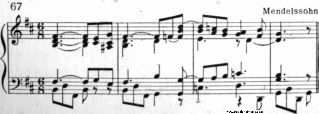EXTEMPORE PLAYING - online tutorial
40 Lessons in how to correctly play improvisations.
| Share page | Visit Us On FB |
|
LESSON XXI |
||
|
Modulation {continued). Other Devices
It will be useful now to tabulate some methods of modulation:
(i) Into next-related keys, by four devices (a, b, c, d).
(2) By the 'stride,' into keys distant by four accidentals in the signature.
(3) Into any key with some connection.
(4) Into a key with no connection, but taken by step.
(5) Change of mode, that is, from major to minor or the reverse. This is not, properly speaking, a modulation, and is made direct, without intervening chords.
In addition to the above classification, modulation may be considered as (a) transient or (b) deliberate.
The first is seen in the course of a section, or even a figure, when the impression of change affects the ear so slightly that it hardly realizes that the original key has been left; e.g., |
||
 |
||
|
It will be felt that in the above the impression of the first is of the key of F; of the second, the key of E.
A deliberate modulation is a different matter, and is found when a phrase or period starts in one key and closes in another. Instances of this abound in every direction, e.g., |
||
 |
||
|
[53] |
||